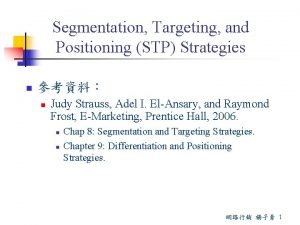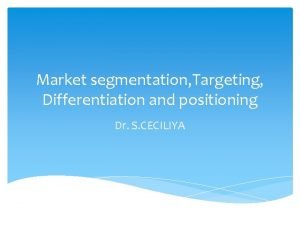The Sequence LOGIC of Segmentation Targeting Positioning STP

- Slides: 1

The Sequence LOGIC of Segmentation, Targeting & Positioning (STP) Strategic Technique Task Function A. Why Marketers Choose Customers 1) Market Segmentation Ø Segmentation Bases/Variables v Demographic …“Descriptors” (age, race, etc. ) v Geographic …“Descriptors” (state, city, ZIP, etc. ) v Psychographic (Lifestyles) …“Descriptors” v Behavior (Usage/Benefits) …“Descriptors” 2) Market Targeting … for Target Marketing Ø Single Segment Strategy (“Concentrated”) Ø Multi Segment Strategy (“Differentiated”) Ø Total Market Strategy (“Undifferentiated”) “Profiling”; Carving the total brand market into segment profiles with BEST “Descriptors” of “Segmentation Bases” (“variables”). Descriptor “x” Descriptor “y” Descriptor “a” “a/x” “a/y” Descriptor “b” “b/x” “b/y” “Picking”; Choosing the segment(s) to “target, ” depending on the likely “fit” between “customer value” & “brand value” * Justify with Segmentation Criteria -- substantial, identifiable/measurable, accessible, responsive B. Why Customers Choose Brands 3) Positioning Ø Analyze brand with “Perceptual Maps” Ø Differentiate with “Positioning Bases” included in “Marketing Mix” (4 Ps) Find top 2 brand attributes for customer 2 nd Form 2 attributes into axes & label low/high 3 rd Identify “ideal point” for customer 4 th Plot all brands for the customer mind axes 5 th Plan moves closer to “ideal point” that leave competitors farther from “ideal point” than your brand using a combination of: a) Repositioning with existing axes categories b) Repositioning with new axes categories “Plotting”; Graph customer “ideal” & brands in Perceptual Map Attribute 1 high 1 st Attribute 2 Brand B * Brand A * low “ideal” * high Brand C * low

